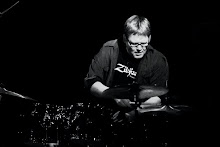Steve Wallace is a good example of this himself. Mike Murley and the Detroit based trumpeter player Marcus Belgrave also come to mind.
Among drummers there are many examples of this. Max Roach and Ed Blackwell would be good examples of melodic, singing style players.
How do we work on this?
1) Try to play the melodies to tunes on the drums. Usually just on the snare drum at first.
Try to leave all the "timekeeping drummer type functions" out of this. In other words. don't play hi-hat on 2 & 4 while you do this, that's not the melody. If the tune has a lot of spaces in it, some much the better. Leave them. Get used to feeling like you're the Sax player or vocalist now, not the drummer. One of the big ways drummers tend to lose lyricism when they play is by rushing through ideas and not leaving space. Melodies breathe but we as drummers can play without needing to take a breath, so this is something we have to learn.
2) Now try to move the melody around the drums but try to:
a) Follow the contour of the melody. For instance the melody to "Sonnymoon for Two" tends to head down in pitch in each 4 bar section. Try to represent the on the drums even if you aren't playing the exact pitches.
b) Repeat pitch patterns. If we look at "SonnyMoon" again we realize that this is a riff blues, meaning the actual melodic material is only 4 bars long and is repeated 3 times over different chords of the blues progression. So try to play the same pitches on the drum set each time you play that 4 bar phrase. This will also help you remember pitch patterns when you improvise, which often helps with unity in drum solos.
Here's a video explanation of the same concept.
3) One thing that struck me a long time ago is Billy Hart saying in an interview that he was always singing. Not just tunes but scales and intervals. I try to do this as well. I think the more we can vocalize, the more we can translate that feeling to our instrument.
4) Finally learn as many melodies (and in the case of tin pan alley tunes lyrics) as you can. Try to use the storytelling aspects of these tunes in your own playing, rather than it being a storehouse of "hip drum things" to play.

No comments:
Post a Comment